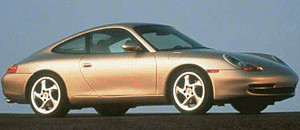 |
 |
Over the previous model's lifetime, its body had been refined several times. However, in the course of its 34-year life, the roofline and windshield had always remained the same as the original 1965 model For 1999, the roofline as well as the windshield and every other body section is totally new.The car's wheelbase has been increased to 92.6 inches (2350 mm), or 3.2 inches (78 mm) more than the previous model. Its overall length has grown to 174.5 inches (4430 mm), an increase of 6.8 inches (170 mm). Its width has grown 1.2 inches (30 mm), up to 69.5 inches (1765 mm) from 68.3 inches (1735 mm). Though the car stands the same 51.8 inches (1315 mm) tall, its laden ground clearance is now nearly one inch (20 mm) less than before. In effect, it's taller as well. Besides more interior space, there is also more storage space thanks to a larger front luggage compartment and more stowage behind the rear seats.
By Smoothing the 911's flanks, raking the windshield more, designing windows that fit flush to the sheetmetal, and minimalizing joints and seams, Porsche's designers have reduced the 911's coefficient of drag from the previous model's 0.34 to 0.30.
From its front bumper to the windshield, the 911 shares its look and contours with the Boxster. From the front A-pillars back, the Carrera is unique. The A-pillars have a more rakish angle than ever before, as the windshield angle has been revised from the previous 60 degrees to 55 degrees.
The car's body is largely constructed of high-strength steel and helps form the vehicle's structure. In fact, the new body is structurally stiffer than its predecessor. Torsional stiffness, or resistance to twisting motions, has been increased by 45 percent. Bending stiffness has been increased by 50 percent. These increases in structural rigidity increase handling performance as well as improving ride comfort and reducing interior noise. Predetermined deformability of the steel plate body helps to minimize loads acting on the carÕs occupant in an accident.
The quieter, smoother ride is complemented by the 911's new passenger cabin. Larger than before with more space in every dimension, the Carrera's passenger compartment offers a new dashboard design, instrument panel layout, dual front and side air bags, a telescoping steering column and an automatic temperature control system. Also noteworthy--for the first time, the 911 has suspended brake and clutch pedals. The accelerator pedal is still floor mounted.
Porsche's new Side Impact Protection System incorporates both energy absorbing door linings and door-mounted air bags which cover the entire side areas regardless of driver and passenger seating positions. The design enhances protection of the driver's and passenger's head, chest, arms and hips.
With its additional wheelbase and increased length, the 1999 911 Carrera has more front and rear legroom as well as cargo space behind the rear seats. Thanks to the lower floor and reshaped roofline, there is also additional headroom. In fact, the new 911 with a sliding sunroof has more headroom than the previous model had without one.
Like the instrument panel of the Boxster, the Carrera offers redundant speedometers--a digitaI speedometer at the bottom of the prominent tachometer echoes the analog unit beside the tach--as well as a coolant temperature gauge.
![[email image]](../Graphics/email.gif)
. Copyright ©1995-98 by AUTOPEDIA, all rights reserved. AUTOPEDIA™, AUTO411™, CAR-IQ™, DEALERPEDIA™, UNILOT™, SIMULSEARCH™ and INTERQUOTE-RFP™ are trademarks of AUTOPEDIA. All other trademarks, tradenames and/or service marks are the property of their respective holders. Although all information and prices contained herein are obtained from sources deemed to be reliable, AUTOPEDIA assumes no responsibility for the accuracy of the information and no liability for any errors and/or omissions. All information is subject to change without notice.